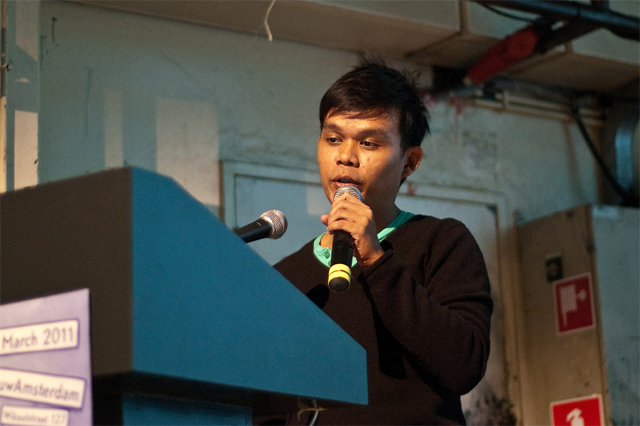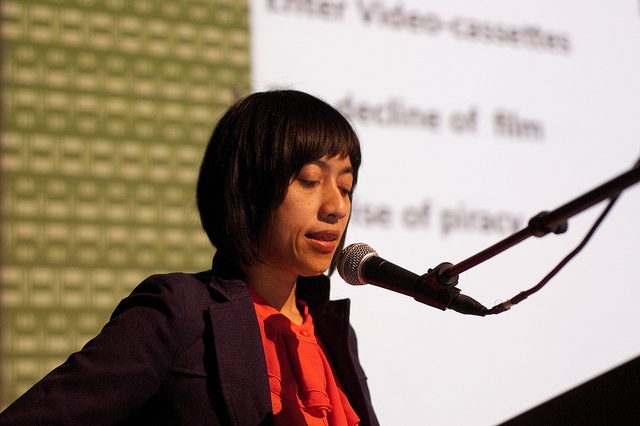
Ferdiansyah Thajib - 'A Chronicle of Video Activism and Online Distribution in Post-New Order Indonesia'. Photo by Anne Helmond.
On the second day of Video Vortex at the Trouw in Amsterstam, Nuraini Juliastuti and Ferdiansyah Thajib explored how video activist in Indonesia, appropriate a variety of distribution strategies. They began with a brief historical overview giving brief a historical overview of video activism in Indonesia. They continued with a mapping of video activism, the prospects and barriers and a brief exploration beyond activism.
At the early stage between 1970 and 1990s it began with an entrance through videocassettes. As explained in Juliastuti and Thajibmain’s book Video Chronic, the New Order saw the potential dangers of the cassettes and took measures to contain and control video practices. Nevertheless, film in Indonesia experienced several boosts, in the late 1980s the production and consumption was increased by the advent of private television stations, between 1991 and 1994 video production rose with fifty percent and in 1995 there was a rise in video piracy which extended the consumption beyond the economic class. This historical overview that they presented and is further explored in the book ‘Video chronic: video activism and video distribution in Indonesia’ shows that video practices in Indonesia are an interplay between production, distribution and consumption. They went on to show that at the end of Suharto’s New Order in 1998 a burgeoning of alternative media such as zines, mailing list and discussion platforms can be seen. These can be seen as alternative media outlets that form channels for discussion that could circumvent repression. According to Juliastuti and Thajib two main ways of media participation can be observed in Indonesia. First there is the empowerment of marginalized communities. Secondly, media participation can be seen as a reaction to the more general exclusions created by capitalist media.

Nuraini Juliastuti - 'A Chronicle of Video Activism and Online Distribution in Post-New Order Indonesia'. Photo by Anne Helmond.
Thajib and Juliastuti went on to explore the intersecting trajectories of video activist, consisting of grassroots-, tactical- and experimental video activism. Grassroots video activist work with specific communities. Online they highlight the ceremonial aspect of being together, they also need video to connect with other events that are going on nationally and globally. Tactical video activist are those who are flexible in the methods of distribution. They use online distribution actively and feel that the mainstream media are not the appropriate channel or means to attain their goals. Tactical activists also use specific sites for their videos, for instance Indymedia. Experimental video activist explore the potentials of video and do more than expire change and intervene. They see online and offline as another way to experiment, connect and as a means of developing themselves.
Despite the rise of the video activism there are still technical barriers to be overcome. The limited bandwidth, particularly outside urban centers, the high-cost of getting access to the Internet and the increasing size of video files are difficulties to be overcome. Not only are there technical barriers but also the public perception is a barrier as well. The moral panic among the aggressor community; fears of being exposed to pornographic materials are mentioned as reason for not installing internet facilities in villages. There is also a digital divide which is not so much about getting access to the tools but is more about how can the tools be used. Media literacy is more an issue than who has access to the Internet, which became evident during the panel discussion after the presentation. Furthermore, the video producers are also concerned with how the material is going to be used and don’t really see the use for putting it online. Most of the producers care more about watching and making the video’s in conjunction with the community and they are not sure how it is going to be perceived and watched online.
The last part of the presentation went beyond video activism. The ubiquity of mainstream video-sharing services opens an area where the non-activist video can be pushed to the public and old media are using more amateur content. Additionally, the police are increasingly using the video’s as evidence, for instance a video of violence on Java, and to identify the actors involved in the events. The question then remains what the activist can do with the videos. Ferdiansyah Thajib concludes the presentation by stating the audience must do more than just view and take action, and that the video’s must emphasize the social change content that already exists offline, this to ensure that the audience is more receptive to these video’s.
The research into video activism in Indonesia has been published as a book (pdf), which can be found on the following website.
http://engagemedia.org/videochronic-english
About the author: Ryanne Turenhout is a master student of New Media and Digital Culture at Utrecht University.


